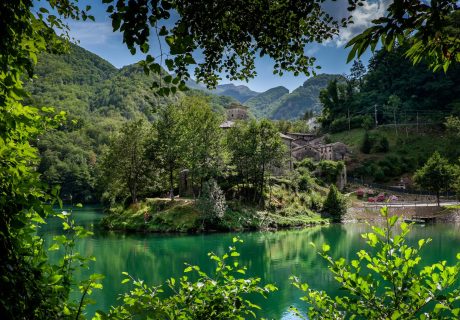5 things to see in Lucca
5 min · 22 Nov 2024

Surrounded by the Apuan Alps and the Garfagnana, Lucca is one of the most beautiful cities in Tuscany and a small jewel with an enormous historical-monumental heritage. Over the course of time, it has been able to change, add, remove, adjust large squares and small alleys, always with great delicacy to offer visitors an ever new experience. Here we have selected 5 things to see in Lucca. But we admit: it was by no means an easy choice, because there are so many things not to be missed!
THE WALLS
As soon as you arrive in Lucca, the first thing that strikes you are its majestic walls. A symbol of the city, they are one of the few examples of walls that have remained completely intact in the Bel Paese. The one that currently exists, built between the 16th and 17th centuries, is the fourth city wall that Lucca has had over time. The people of Lucca love this place very much, where they go walking, cycling and jogging. Walking along the walls, among centuries-old trees such as plane trees, horse chestnuts and oaks, one can also see unprecedented glimpses of the city’s main monuments. Near Porta Elisa (one of the six gates of the walls), the garden encroaches on the Botanical Garden, established in the early 19th century at the behest of Duchess Maria Luisa of Bourbon.
CATHEDRAL OF SAINT MARTIN
Among the things to see in Lucca, we cannot fail to mention the Cathedral of San Martino, one of the most interesting and oldest churches in the whole of Tuscany. Situated in the square of the same name, it was founded in the 6th century by San Frediano, bishop of Lucca, although its current appearance is the result of various renovations over time. On the outside, the Romanesque façade is striking for its asymmetry, while inside, in addition to the polychrome marble floors and paintings by Tintoretto and Ghirlandaio, there are two works of art that are symbolic of the city: the sarcophagus of Ilaria del Carretto, a Renaissance masterpiece by Jacopo della Quercia; and the ancient wooden crucifix of the Volto Santo, which, according to legend, was sculpted by Nicodemus. Many tourists visit it, but few know that on the right pillar of the entrance portico is a mysterious labyrinth with a Latin inscription evoking the myth of Theseus and Ariadne.
GUINIGI TOWER
Between Via Sant’Andrea and Via delle Chiavi d’Oro, the Guinigi Tower stands proud and elegant, on top of which is a hanging garden with large, centuries-old holm oaks. Together with the nearby Torre delle Ore, it is the only one of the more than 250 towers that enriched the city in medieval times to have remained intact. Built in the second half of the 14th century in the Roman-Gothic Tuscan style, it owes its name to the rich and powerful family of merchants and bankers from Lucca, to whom it belonged continuously until 1968. To reach the top you have to climb a good 230 steps (spread over 25 ramps) but it is really worth it. From its 45-metre height, one can enjoy a spectacular and original view of the old city centre and the surrounding hills.
PIAZZA DELL’ANFITEATRO
Piazza dell’Anfiteatro, also known as Piazza del Mercato (because it was used for centuries as the city’s market place), is one of the most popular meeting places for the people of Lucca. Its name and particular elliptical shape testify to its origins. It was built on the remains of the ancient Roman amphitheatre (2nd century A.D.), today buried about three metres underground, to a design by the famous Lucchese architect Lorenzo Nottolini, who in 1830 freed the space of the arena from the constructions that had been erected there over the centuries and created the street known as the Amphitheatre, which traces its elliptical profile on the outside. The square is accessed through four gates and in the centre is a cross engraved on a tile marking the perfect intersection between the gates. Having an aperitif at sunset here is an experience not to be missed.
BASILICA OF SAINT FREDIANO
Very close to Piazza dell’Anfiteatro is the Basilica di San Frediano, one of the city’s oldest places of worship. Located in the square of the same name, according to tradition it was founded in the 6th century by San Frediano himself. On the foundations of the first sacred building, the present basilica in Romanesque style was later erected (starting in the 12th century). The church is famous for the large mosaic on the façade, dating back to the end of the 13th century, which is spread over two registers, the lower one with the apostles, in a more Romanesque style, and the upper one with Christ ascending into the mandorla, in a Byzantine style. On the other hand, inside, the statues by Jacopo della Quercia in the Trenta chapel and the fresco cycle by the Emilian painter Amico Aspertini in the chapel of St. Augustine stand out.








